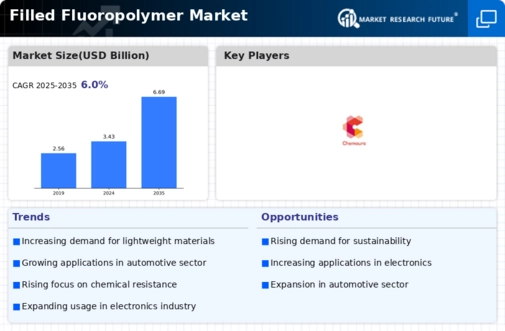Top Industry Leaders in the Filled Fluoropolymer Market
 Filled fluoropolymers, engineered composites with exceptional properties derived from the marriage of base fluoropolymers like PTFE and strategic fillers, occupy a unique and crucial niche in the materials world. Their exceptional chemical resistance, thermal stability, low friction, and electrical insulation properties find application in diverse sectors, from aerospace and semiconductors to chemical processing and medical devices. Understanding the competitive landscape of this dynamic market is essential for both established players and newcomers seeking to thrive in this space.
Filled fluoropolymers, engineered composites with exceptional properties derived from the marriage of base fluoropolymers like PTFE and strategic fillers, occupy a unique and crucial niche in the materials world. Their exceptional chemical resistance, thermal stability, low friction, and electrical insulation properties find application in diverse sectors, from aerospace and semiconductors to chemical processing and medical devices. Understanding the competitive landscape of this dynamic market is essential for both established players and newcomers seeking to thrive in this space.
Strategies Fueling Growth:
Leading players like The Chemours Company, Daikin Industries, and AGC Chemicals employ a range of strategies to maintain their market dominance:
-
Product diversification: Expanding portfolios to cater to specific performance requirements in niche applications. This includes developing filled fluoropolymers with enhanced conductivity, wear resistance, or flame retardancy. -
Technological innovation: Investing in R&D to create novel filler combinations, optimize processing techniques, and explore sustainable alternatives like bio-based fillers. -
Regional expansion: Targeting high-growth markets like Asia Pacific and Latin America by establishing local production facilities and tailoring offerings to regional needs. -
Vertical integration: Gaining control over the supply chain by acquiring raw material suppliers or expanding into downstream applications like finished parts manufacturing. -
Strategic partnerships: Collaborating with research institutions, universities, and startups to accelerate innovation and access new technological expertise.
Factors Dictating Market Share:
Success in this competitive landscape hinges on several key factors:
-
Product quality and performance: Delivering filled fluoropolymers with consistent properties, exceeding industry standards, and ensuring reliable performance under demanding conditions. -
Cost competitiveness: Balancing high quality with competitive pricing, especially in cost-sensitive sectors like automotive and electronics. -
Technological leadership: Continuously innovating and staying ahead of the curve with advancements in filler engineering, processing technologies, and material optimization. -
Customer service and support: Building strong relationships with clients through technical expertise, prompt deliveries, and efficient after-sales support. -
Environmental consciousness: Demonstrating a commitment to sustainability by utilizing recycled materials, exploring bio-based fillers, and minimizing environmental impact during production.
Competitive Landscape:
3M (US),
Mitsubishi Chemical Corporation (Japan),
AGC Inc. (Japan),
The Chemours Company (US),
Shashi Fluoroplastiks (India),
DAIKIN INDUSTRIES, Ltd. (Japan),
U-Tech Polymers (India),
AFT Fluorotec Ltd (UK),
HaloPolymer,
OJSC (Moscow),
HINDUSTAN NYLONS (India),
Standard Fluoromers Pvt. Ltd. (India),
FLUORTEN (Italy).
Recent Developments:
July 2022: Daikin Industries Ltd’s investments were directed towards US-based start-up TeraWatt Technology so as to develop applications and improve lithium-ion batteries’ technology further.
Thus, PPG presented its newest Lineguard line of coatings as well as application services for tier suppliers, industrial customers and automotive OEMs in October 2021 to reduce costs associated with maintaining several types of paint shop equipment, including time spent performing maintenance activities alongside risks arising during painting operations as well as environmental consequences from using traditional paint removers containing hazardous components such a methylene chloride.
February 2022 - Daikin Industries is working on developing Fluoropolymer PFA for powder bed fusion.
June 2021 – a new Kynar CTO polyvinylidene fluoride was introduced by Arkema. These new grades will ensure that all carbon in them is renewable and derived from bio-feedstock obtained from crude tall oil.
On 25 May 2021, Arkema announced the acquisition of Agiplast to develop high-performance polymers. Additionally, the company targets bringing about material circularity with respect to customers’ needs as well as growing expectations within the manufacturing sectors. This means that Arkema will integrate high-performance polymers consisting of both bio-based and recycled materials.

